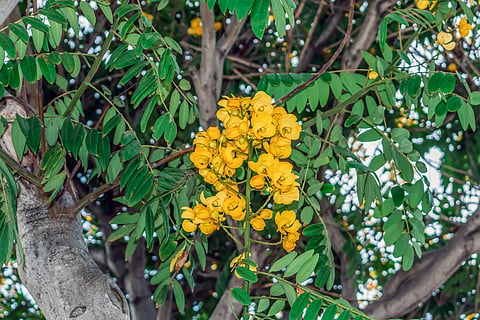

Senna spectabilis, introduced in the 1980s, has spread across the Nilgiri Biosphere Reserve, choking native plants and food sources for wildlife.
Kerala has carried out India’s first science-based, community-led eradication in Wayanad, clearing 383 acres of infested forest.
A hand-held uprooting tool designed by a marine engineer made large-scale removal possible.
Scientists warn Senna’s invasion has worsened human–wildlife conflict in Wayanad, Bandipur and Mudumalai.
For decades, the golden blooms of Senna spectabilis deceived South India’s forests. Introduced from South America in the 1980s, the fast-growing tree was planted for shade, beautification and firewood. Its resemblance to Kerala’s beloved state flower Cassia fistula, known locally as kanikkonna, sealed its popularity among forestry officials.
What seemed a miracle species has since turned into one of India’s most destructive ecological mistakes. Senna forms dense, sterile thickets, choking out native plants, altering soil chemistry and depriving herbivores of food. Its rapid spread across one of Asia’s most critical wildlife corridors, Nilgiri Biosphere Reserve, has quietly accelerated biodiversity collapse and intensified human-animal conflict.
Now, in a corner of Kerala’s Wayanad Wildlife Sanctuary, a different story is beginning to take root.
In the Tholpetty range of Wayanad, Kerala has recorded India’s first science-based, community-driven eradication of Senna spectabilis. Over 383 acres of infested forest have been cleared, 46,450 trees uprooted, their root systems destroyed to prevent regrowth. The eco-restoration covers 560 acres in total and already the forest is showing signs of recovery: grasses sprout where none had grown for decades, herbs return, birdsong fills the air and elephant dung reappears in areas once abandoned by wildlife.
“This was not a cosmetic operation. We went deep, literally,” said Meera Chandran, co-founder of the Wayanad-based group Forest First Samithi. “Cutting doesn’t work. Senna resprouts. We had to pull out every root.”
A breakthrough came when marine engineer A Anand designed a lightweight, hand-held uprooting tool. It allowed even untrained workers to extract entire root balls, making eradication feasible on a large scale.
Behind this success lies what is being called the “Wayanad model”: a partnership between the Kerala Forest Department, Forest First Samithi and tribal youth from the Kurichiya and Kattunaikka communities. They were trained not just as labourers but as guardians of restoration.
“We grew up watching these forests change,” said a young tribal worker from Mananthavady. “Earlier, you could walk for hours in Senna thickets without hearing a bird. Now, the forest is alive again.”
Restoration efforts have already seen 80 native tree species replanted, 15 indigenous grasses return naturally and 184 bird species documented in post-Senna zones. Large mammals are following, as elephants and deer are once again frequenting reclaimed patches.
The urgency is stark. Each Senna tree produces up to 6,000 seeds a season. The seeds remain viable for nearly a decade. Trees flower within two years and even bark-stripped stumps resprout within weeks.
“Senna wipes out the food base for herbivores,” warned TV Sajeev, senior scientist at the Kerala Forest Research Institute. “Without grasses and shrubs, deer and gaur decline. Tigers and elephants are then forced to move into human settlements. The surge in human-wildlife conflict in Wayanad, Bandipur and Mudumalai has a direct link to this invasion.”
A 2021 Rufford Foundation study estimated that Senna had taken over 23 per cent of Wayanad Wildlife Sanctuary in just four decades. That figure is now thought to exceed 40 per cent. Kerala Forest Department estimates put the invasion at 800 hectares in Wayanad alone.
The success at Tholpetty is now shaping policy. Forest First Samithi has signed a memorandum of understanding with the Karnataka Forest Department to extend eradication into the DB Kuppe range of Nagarhole Tiger Reserve, India’s first cross-border Senna removal project. Tamil Nadu too is considering similar measures.
Meanwhile, governments are experimenting with ways to use the felled biomass. A recent pilot converted Senna wood into 6,000 tonnes of paper pulp. But ecologists caution that unless roots are fully removed, harvesting for industry will do little to halt the invasion.
Other states are on alert. Reports of Senna proliferation are emerging from Andhra Pradesh, Goa and parts of Maharashtra. Conservationists warn that unless tackled early, these regions may repeat south India’s mistakes.
“This is not about a single weed,” says Chandran. “Across India, invasive species like Lantana, Eupatorium, Acacia and Senna are erasing ecosystems silently. If we don’t act now, we risk losing the very forests we claim to protect.”
Tholpetty’s fight isn’t over yet. After each clearing, a year-long scouting operation follows, including daily patrols to spot and destroy new seedlings before they can take hold.
The work is slow and painstaking. But for the first time, the tide seems to be turning. Here, forest restoration is not about planting trees but about “un-planting” them by digging up mistakes to give the Nilgiri forests a second chance.